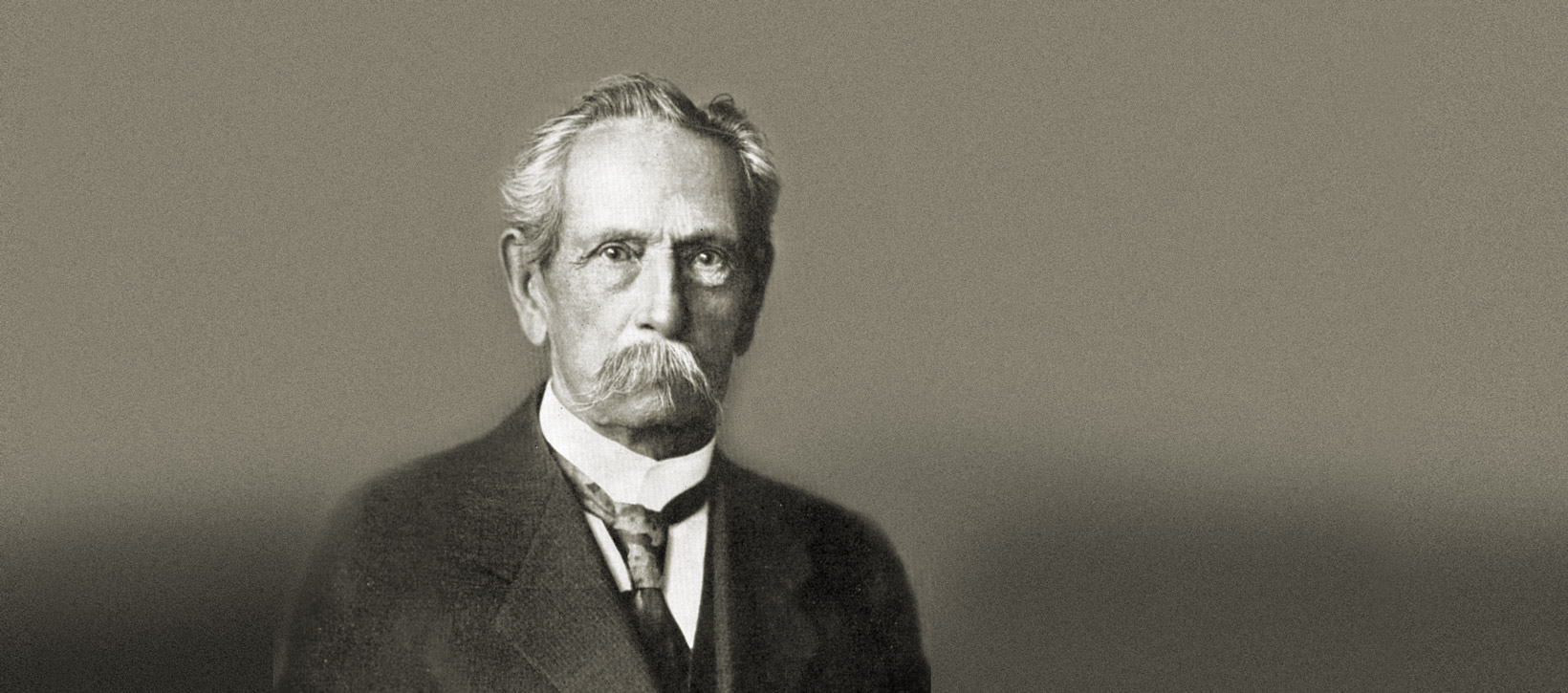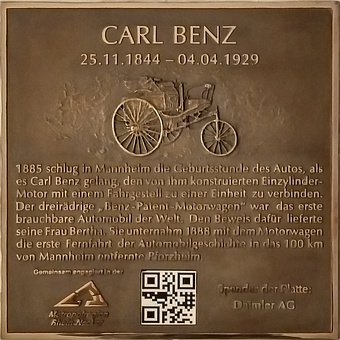1885 Automobile
Carl Benz (11/25/1844 - 04/04/1929)
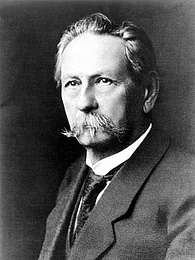
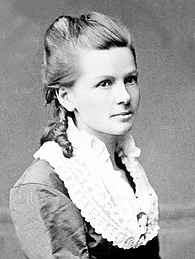
Carl Benz was born on November 25, 1844 in the small town of Mühlburg, now a district of Karlsruhe. His father, a locomotive driver, died when Carl was less than two years old. Nevertheless, his mother, , enabled the gifted boy to receive a good education. After attending the Karlsruhe Lyceum, Carl studied mechanical engineering at the Karlsruhe Polytechnic.
During an excursion to Maulbronn, the 22-year-old engineer met Bertha Ringer and became engaged to her in 1870 . Soon after, he settles in Mannheim and founds a mechanical workshop in T 6 with the mechanic August Ritter . But the success fails to materialize and so the business partners soon part ways again. Carl Benz is only able to save the workshop thanks to his bride's dowry. He renames it "Carl Benz Eisengießerei und mechanische Werkstätten" (Carl Benz iron foundry and mechanical workshops). In July 1872 Carl and Bertha Benz marry and one year later settle in a small house on the workshop premises.
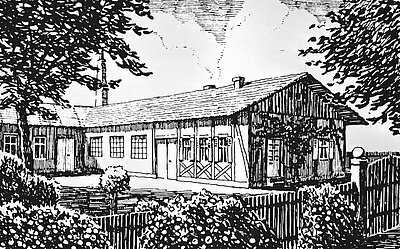
In the years that followed, Carl Benz devoted himself to the design of engines. On New Year's Eve 1879, he succeeded in getting his stationary gasoline engine to run for the first time. Carl Benz later wrote in his memoirs: "What no magic flute in the world has been able to do, the two-stroke engine can now do. The longer it sings, the more it conjures the oppressively hard worries from the heart. Suddenly, the bells began to ring. New Year's Eve bells. We felt as if they were ringing in not just a new year, but a new era."
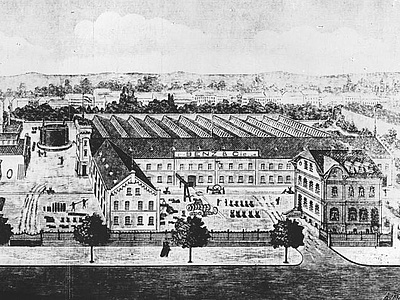
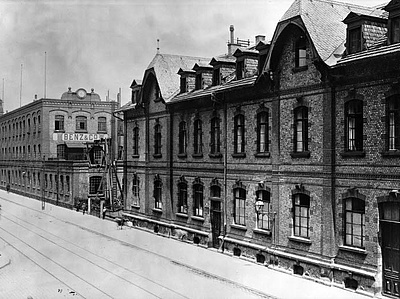
In order to obtain a loan for the costly further development of his engines , Carl Benz transforms his company in 1882 into a stock corporation, the "Gasmotorenfabrik in Mannheim AG". However, since profits are important to the supervisory boards of his new company, they have little sympathy for the vision of the horseless carriage. Carl Benz therefore left the company and founded "Benz & Cie Rheinische Gasmotorenfabrik" with new partners in 1883. At last he is able to devote himself to the design of his motor car in addition to the production of gas engines. 1884 his single-cylinder four-stroke engine with 0.75 hp is running. Now Carl Benz can develop the other parts necessary for his motor carriage, such as carburetor, ignition, clutch, radiator, brakes and a kind of gear shift and install them in a three-wheeled chassis with spoked wheels and solid rubber tires .
When Carl Benz first took to the road in the summer of 1885 after test drives in the factory yard with the motorized vehicle , he was ridiculed, and not a few people even found the loudly rattling and quite moving vehicle without horses scary. . Although Carl Benz was granted a patent for his motorized car on November 2, 1886, the car was not a success from an economic point of view. Only the Generalanzeiger der Stadt Mannheim (General Gazette of the City of Mannheim) believed in September 1886 that this vehicle would have a future. Bertha also believes in this, and above all in her husband , and encourages him to continue working on improving the motor carriage.
Production of the stationary gas engines is so successful that the company is able to move to a new plant at Waldhofstrasse 24 in 1887.
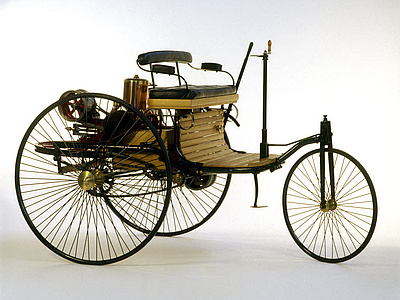
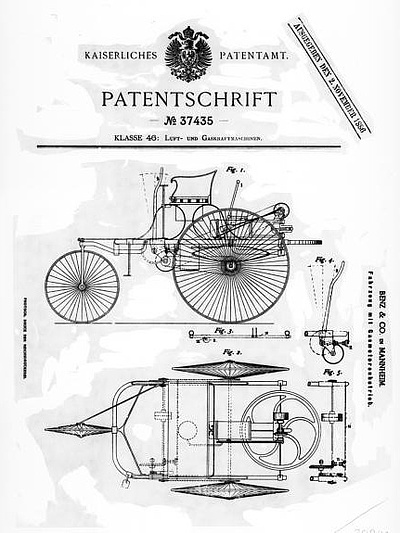
The Patent-Motorwagen but first becomes popular, when the courageous Bertha undertakes an adventurous long-distance drive in the improved model 3 without her husband's knowledge at the beginning of August 1888. Together with her two sons, aged 13 and 15, she drives from Waldhofstrasse on dusty and bumpy roads to her mother's home in Pforzheim, 106 kilometers from Mannheim. In doing so, she proves that the Patent Motor Car is not a spinning machine, but rather a vehicle suitable for everyday use and extremely useful. The "Bertha Benz Drive" is held every two years on this historic route to commemorate this first long-distance drive in the history of the automobile.
In 1893, Carl Benz also finds a solution for steering when he reads a report in a trade journal about a steering system for horse-drawn carriages that had already been patented in 1816. Carl Benz recognizes that this functional principle, applied to the car, solves the steering problem and designs a steering knuckle for his patented car. He builds this into his first four-wheeled car, the "Viktoria" model . It becomes his favorite car, the later in Ladenburg with his house a place of honor receives. 1894 follows the "Benz Velo", a small low-priced car, which is produced in a series of approximately 1200 copies and 1895 the first motor bus for the regular traffic.
After disagreements with the shareholders, Carl Benz left the company in 1903, but returned as a member of the supervisory board in 1904. In the same year, he starts building a new factory in Ladenburg. The family moves to Ladenburg in 1905 . Together with his sons Eugen and Richard, Carl Benz founds the company "Carl Benz Söhne" in Ladenburg in 1906, leaving its management to his sons six years later. Today, the historic factory building houses the "Automuseum Dr. Carl Benz".
In 1914, the Technical University of Karlsruhe awards Carl Benz an honorary doctorate. In 1926, "Benz & Cie. Rheinische Gasmotorenfabrik Mannheim" and "Daimler- Motoren-Gesellschaft", founded by Gottlieb Daimler, merged to form "Daimler-Benz-AG".
On April 4, 1929, Carl Benz died in Ladenburg at the age of 84 and was buried there&.
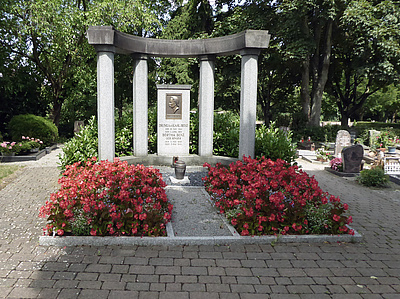
Tour from the bronze plate along the sites of activity to the tomb
The bike tour begins in front of the Mannheim Baroque Palace and runs through the sites and monuments to the tomb of Carl and Bertha Benz in Ladenburg.
Waypoints
- The starting point is the bronze plaque in honor of the innovator Carl Benz, the inventor of the automobile,
- The trail leads to the water tower and the monument to the Benz Patent Motor Car.
- Then it goes into the city center to the square T6, 11, where Carl Benz's workshop was located.
- Along the Neckar the way leads to Ladenburg to the car museum Dr. Carl Benz.
- Then to the Carl Benz Park with garage and residential house
- The tour ends at the Ladenburg cemetery at the tomb of Carl and Bertha Benz
